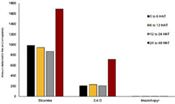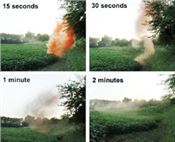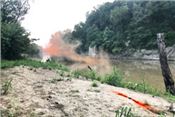Synthetic Auxin Applications 2021: How Does The Air Flow In Your Fields?
DR. MANDY D. BISH AND DR. KEVIN BRADLEY
COLUMBIA, MO.
With support from the United Soybean Board, we conducted three different volatility studies in 2020 in collaboration with researchers from four other universities. Our observations from those studies indicate that dicamba-containing products (Engenia and Xtendimax) are more volatile than the 2,4-D products (Enlist One and Enlist Duo). Figure 1 shows the results from one of these experiments.
Synthetic auxin herbicides like 2,4-D and dicamba can be susceptible to off-target movement through volatility, if they are sprayed during an inversion, or if droplets volatilize into the stable air.
Vertical winds will typically prevent inversions or stable air masses from forming during mid-day in most geographies. However, when a temperature inversion forms and the air becomes stable and cool, there can be a common pattern as to how that stable air moves within or out of the field. This is highly dependent on the topography of the field.
Cool air is dense and will move to the lowest area, carrying any particulate trapped with it.
In 2020, we released smoke bombs during inversion-like conditions in locations with different topographies. Figure 2 shows a smoke bomb released in a soybean field in mid-Missouri. The red cloud looks like it is going to dissipate at about 30 seconds, and then, the particulates regroup, sink, and move towards the lowest edge of the field, which happens to be near a riverbank. This is where we would anticipate any pesticide trapped in the stable air to move as well.
The movement of the air in that particular field was very different than what we observe when we release a smoke bomb at our Bradford Research Center which has a mostly flat and open terrain. When a cool air mass forms at Bradford, there is no certainty as to which direction the air mass will move. At sites such as the one shown in Figure 2, the elevation differences help dictate what direction stable air is going to flow.
We also set off a smoke bomb along the riverbank near the soybean field shown in Figure 2 to see what might happen if a pesticide- contaminated air mass made it to the river. The red cloud moved down stream, staying mostly intact until it was out of site (Figure 3).
So why should all of this be important to you? If you understand the air flow in a given field, you will better understand where pesticide droplets that remain in the air are most likely to move. Smoke bombs have become a pretty good educational tool for us in understanding stable air masses and air movement. Feel free to try these out in your own fields as well. Just remember to "deploy" them in the evenings once inversion have typically formed in order to see where stable air masses are most likely to move and/or settle. We have only used the Enola Gaye smoke bombs, but there are a variety of different options on the market. ∆ DR. MANDY D. BISH: Research Specialist, University of Missouri DR. KEVIN BRADLEY: Associate Professor, University of Missouri

Figure 1 Volatility of dicamba and 2,4-D herbicides as measured by air sampling over time. Imazethapyr was applied in a tank mixture with each product as a control.
Each bar represents the sum of 3 air samplers. A labeled rate of each herbicide was sprayed at the same time. The dicamba product was Xtendimax (plus glyphosate)
and the 2,4-D product was Enlist One (plus glyphosate).

Figure 2 The smoke bomb was released, and the red cloud eventually moved towards the lowest-lying area in the field, near the
river. The smoke bomb was released, and the red cloud eventually moved towards the lowest-lying area in the field, near the river.

Figure 3 The red cloud moving downstream along the river remains mostly intact.